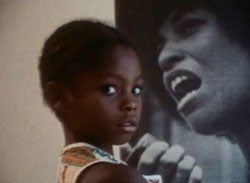I intuitively knew as soon as I saw this still from Haile Gerima’s Ashes & Embers (1982) that it had to be our signature image for the Archive’s fall program at the Billy Wilder Theater, “L.A. Rebellion: Creating a New Black Cinema.” It wasn’t that we didn’t have countless other beautiful still images, gathered from the work of the more than 50 L.A. Rebellion filmmakers originating at UCLA. But this one encapsulated so much of the spirit of the Rebellion.

What makes this image so compelling is its formal excellence as a photographic image, its deeply humanistic view, and its metaphorical richness. But that first intuitive response was triggered by the returned gaze of the beautiful, inquisitive and innocent child that is the hope for all our futures. We see her in living color because she is (or was) a real child, not some Hollywood actress, a child with her own hopes and dreams. With some exceptions, the actors in the L.A. Rebellion films were all non-professionals—real people in the community—just as the films themselves grew out of a community.
In a perfectly balanced circular design, the child holds our attention, despite the overpowering compositional presence of Angela Davis in a black-and-white poster in the background. Davis is a living icon, the intellectual hope of the child to whom she metaphorically speaks; nevertheless, she is more idea than flesh and bone, in contrast to the realness of the child.
"That same black-and-white poster is seen in more than a handful of L.A. Rebellion films, which was their way of paying homage to one of their intellectual roots."
So it was for the budding African and African American filmmakers of the Rebellion. That same Angela Davis poster hung in countless college dormitories (both black and white) from the late 1960s onwards, a signifier of the Black Revolution. But her countenance was also visible all over the African American community, indeed all over the world, a symbolic leader of the struggle for liberation for all people of color. That same black-and-white poster is seen in more than a handful of L.A. Rebellion films, which was their way of paying homage to one of their intellectual roots. Haile Gerima’s Child of Resistance (1972) is a direct reaction to, and meditation on, the incarceration of Angela Davis off the UC Berkley campus. Davis represents for the Rebellion both the contemporary international struggle for equality and the tortured history of African Americans in this country. And that history is also present in the Rebellion films, analyzed and dramatized.
But I want to return to the young girl. Beyond her human beauty, she gives form to all that is new and exciting about the L.A. Rebellion, their youthful exuberance, their utopian vision of a better society, their sensitivity to children and gender issues, their willingness to question any and all received wisdom, their identification with all the young liberation movements in the Third World, their expression of black pride and dignity.






 Mobile Navigation
Mobile Navigation

